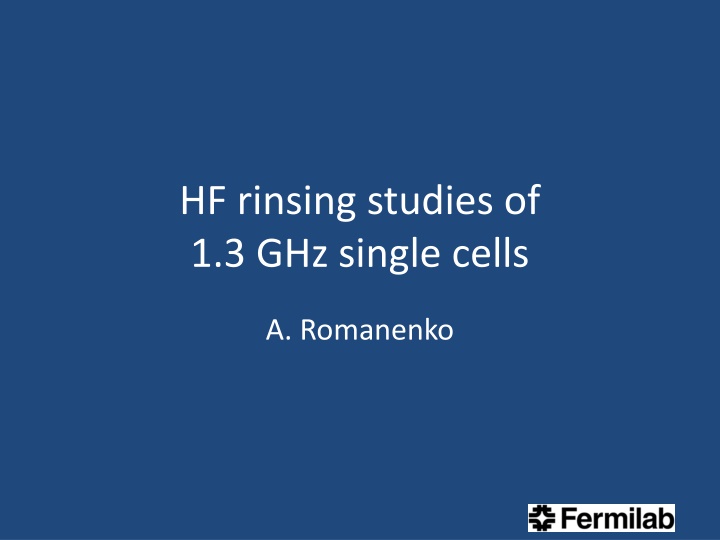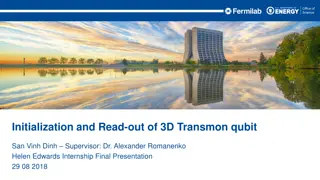
High Frequency Rinse Studies for Niobium Superconducting Cavities
Explore the impact of HF rinsing on optimizing medium Q0 in niobium superconducting cavities through anodizing experiments and rinse procedures. Discover results showcasing improvements in Q0 values and high field Q-slope after multiple rinse cycles.
Download Presentation

Please find below an Image/Link to download the presentation.
The content on the website is provided AS IS for your information and personal use only. It may not be sold, licensed, or shared on other websites without obtaining consent from the author. If you encounter any issues during the download, it is possible that the publisher has removed the file from their server.
You are allowed to download the files provided on this website for personal or commercial use, subject to the condition that they are used lawfully. All files are the property of their respective owners.
The content on the website is provided AS IS for your information and personal use only. It may not be sold, licensed, or shared on other websites without obtaining consent from the author.
E N D
Presentation Transcript
HF rinsing studies of 1.3 GHz single cells A. Romanenko
Motivation Anodizing experiments (Eremeev et al, SRF 2005, TuAO8; Ciovati et al, PRST AB 10, 062002 (2007)) demonstrated that the depth of the layer modified by 120C baking is about 20 nm Distribution of lossy layers within this depth can be explored by step-by-step material removal HF rinsing as a tool for that Maybe maximization of medium Q0 possible in the process selecting the highest Q layer 3/18/2025 A. Romanenko
Anodizing experiments Eremeev et al, SRF 2005, TuAO8 Fine grain EP cavity Ciovati et al, PRST AB 10, 062002 (2007) Large grain BCP cavity 3/18/2025 A. Romanenko
HF rinse - principle Water rinse grows new oxide layer ~5nm Nb2O5 HF acid dissolves natural oxide layer Nb2O5 ~2nm RF layer RF layer Nb RF layer Nb Nb ~2nm Each HF/water rinse step consumes about 2 nm of niobium from the top of the RF layer determining the surface resistance and moves deeper into the bulk depth profiling of the losses 3/18/2025 A. Romanenko
HF rinse procedure Filling with HF HF dumping 5 minutes hold DI water rinse 3/18/2025 A. Romanenko
Reproducibility Retest after HPR/reassembly Original test 2x1010 Q0 1x1010 0 0 20 40 60 Hpeak (mT) 80 100 120 140 160 3/18/2025 A. Romanenko
Results on EP fine grain (tumbled) 9 120C baked +HF rinse 8 7 EP +120C +HF +HF(2) +HF(3) +HF(4) +HF(5) 10 5x10 T = 2 K 6 Rs (nOhm) 5 4 3 Rres ~ 2 nOhm 10 4x10 2 Rres < 1 nOhm 1 0 0.50 0.55 1/T (K-1) 0.60 0.65 10 3x10 Single HF rinse after mild baking significantly improves medium field Q0 Multiple HF rinse cycles do bring the high field Q-slope back Onset field is still higher than before baking by ~25 mT after total 5 HF rinse cycles Further rinses in queue Q0 10 2x10 10 1x10 0 0 20 40 60 80 Hpeak, mT 100 120 140 160 180 200 3/18/2025 A. Romanenko
Results on EP fine grain cavity T = 2 K Single HF rinse improves low and medium field Q0 Six HF rinses do bring the high field Q-slope back but with the higher onset (~125 mT vs 100 mT) 10 4x10 EP+120C +HF +HF (6 total) 10 3x10 Q0 10 2x10 10 1x10 0 0 20 40 60 80 100 120 140 160 180 Hpeak, mT 3/18/2025 A. Romanenko
Results on BCP fine grain cavity T = 2K BCP +120C +HF +HF (2 total) +HF (3 total) +HF (4 total) +HF (5 total) 10 5x10 Single and double HF rinse cycles significantly improve medium field Q0 High field Q-slope is present after mild baking 10 4x10 10 3x10 Q0 10 2x10 10 1x10 0 0 20 40 60 80 100 120 140 Hpeak, mT 3/18/2025 A. Romanenko
Development of higher Q recipe for Project X BCP +120C + HF rinse Tumbled + EP + 120C + HF rinse 3x1010 4x1010 35% 30% 2x1010 3x1010 Q0 Q0 1x1010 2x1010 T=2K T=2K 0 1x1010 0 20 40 60 80 100 120 140 -20 0 20 40 60 80 100 120 140 160 180 200 Hpeak (mT) Hpeak (mT) FNAL single cell data -> single HF rinse (5 min) followed by water rinse is beneficial for the medium field Q value gains of up to 35% measured at 70 mT EP + 120C + HF rinse 3x1010 11% Q0 2x1010 T=2K 1x1010 0 20 40 60 80 100 120 140 160 180 Hpeak (mT)
Literature 120C enhances residual resistance; possibly due to suboxide formation Single HF rinsing and regrowing oxide restores residual resistance to pre-bake state while keeping the improvement in RBCS Possible interpretation After 120C +HF rinse ~5nm Nb2O5 Nb2O5 Layer of high residual losses +5 HF rinses Baking modified - no HFQS losses Baking modified - no HFQS losses Nb2O5 Nb ~20nm Nb An estimate of the remaining thickness from the HFQS onset: 125 mT * exp (-h/ ) = 100 mT => h~8nm B=B0exp(-z/ ) Bulk susceptible to HFQS losses Bulk susceptible to HFQS losses Bulk with HFQS losses 3/18/2025 A. Romanenko
Conclusion HF profiling results are so far consistent with the layer of 10-20 nm being modified by mild baking Practically - single HF rinse/DI water rinse after 120C mild baking appears to be a simple route to increase the medium field Q0 by 10- 35% in fine grain cavities Important for Project X and other CW projects 3/18/2025 A. Romanenko
Acknowledgements J. Ozelis cavity testing A. Rowe, D. Bice, T. Reid, R. Murphy cavity processing 3/18/2025 A. Romanenko

